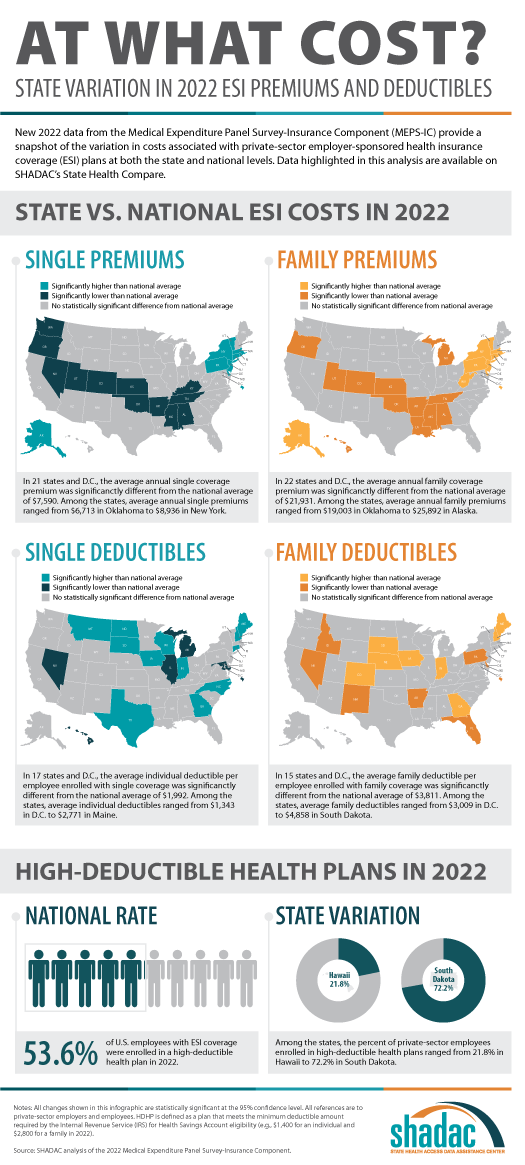SHADAC Expertise
Health Care Cost and Affordability
Health care cost and affordable health care are understandably at the forefront of consumer concerns as studies show rising health care spending across the nation. For over a decade, SHADAC has monitored and produced reports on health care cost and affordability trends through primary data collection and secondary data analysis. SHADAC’s work on these subjects ranges from studies involving primary data collection to assess costs of care, such as care coordination costs; to secondary data analyses of individuals who forgo needed medical care or make changes to prescription drugs due to cost; and of increasing premiums and deductibles in our annual employer-sponsored insurance report. SHADAC staff have also modeled the projected use and cost of Medicaid spending on long-term services and supports for Medicaid enrollees.
Related SHADAC Work:
Click on any title below to learn more about the project.
 Affordability and Access to Care: Examining Inequities Across the United States
Affordability and Access to Care: Examining Inequities Across the United States
Various SHADAC analyses examine Americans’ health care costs, access to care, and ability to afford medical care. Many of our analyses explore inequities related to race/ethnicity and education, often using measures from SHADAC’s State Health Compare, including: Adults Who Forgo Needed Medical Care, Health Insurance Coverage by Type, and Adults with No Personal Doctor. The graphic to the right, featured in one of our analyses using 2018 BRFSS data, explored inequities in health care cost and access based on race/ethnicity and education. In one of our latest publications on the topic of health care cost and affordable health care, researchers analyze Forgone Care by Coverage Type, which revealed that 63% of adults without health coverage reported forgone care while no more than 14% of those with coverage reported forgone care. Find the full analysis here; explore this and other data on State Health Compare.
State and Federal Relief Prevented Deep Backslide in Health Care Affordability in California in 2020
There were well-founded fears that the pandemic, and the concurrent economic crisis, could make health insurance and health care unaffordable for even more people — already a long-standing problem in California. This analysis of the California Health Insurance Survey (CHIS) shows that Californians were largely protected from experiencing a major erosion in their ability to pay for health insurance and care. Despite this overall positive finding, the 2020 CHIS data on health care affordability continue to demonstrate clear inequities by income and race/ethnicity.
Employer-Sponsored Insurance: A National-Level Look at Cost and Coverage Rates

 Throughout the United States, a majority of Americans and their families receive health insurance coverage through their employer. In 2021, the number of individuals enrolled in this type of coverage – known as employer-sponsored insurance or ESI – exceeded 62.2 million. In this blog, infographic, and companion documents, SHADAC researchers use data from the Medical Expenditure Panel Survey-Insurance Component (MEPS-IC) to analyze the private-sector ESI landscape in 2021 on a national level and within the states. We used the following year's data from the same source and compared 2022 vs 2021 in terms of employee access to coverage, health care cost for employees, and more in this blog and accompanying infographic.
Throughout the United States, a majority of Americans and their families receive health insurance coverage through their employer. In 2021, the number of individuals enrolled in this type of coverage – known as employer-sponsored insurance or ESI – exceeded 62.2 million. In this blog, infographic, and companion documents, SHADAC researchers use data from the Medical Expenditure Panel Survey-Insurance Component (MEPS-IC) to analyze the private-sector ESI landscape in 2021 on a national level and within the states. We used the following year's data from the same source and compared 2022 vs 2021 in terms of employee access to coverage, health care cost for employees, and more in this blog and accompanying infographic.Past Work
2018 State-Level Estimates of Medical Out-of-Pocket Spending for Individuals with Employer-Sponsored Insurance Coverage
As part of SHADAC’s work monitoring trends in coverage, access, and affordability, this brief highlights the affordability of coverage for those with employer-sponsored health insurance (ESI). Using data from the Current Population Survey (CPS), SHADAC estimated family out-of-pocket costs for people with employer coverage across all 50 states and the District of Columbia (D.C.). Additional analysis looked at family median out-of-pocket costs by state and estimated the high medical cost burden where family out-of-pocket spending is greater than 10% of household income.
Minnesota Health Care Home Care Coordination Cost Study
The Minnesota Department of Human Services and Health contracted with SHADAC to conduct a study of the costs of Health Care Home care coordination for adults. In order to estimate the cost of care coordination, SHADAC used a case study approach and developed a list of activities (or “ingredients”) that define care coordination and collected information about the costs associated with each of these activities at six non-acute, primary care clinics.




